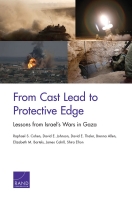| 来源类型 | Research Reports
|
| 规范类型 | 报告
|
| DOI | https://doi.org/10.7249/RR1888
|
| ISBN | 9780833097873
|
| 来源ID | RR-1888-A
|
| From Cast Lead to Protective Edge: Lessons from Israel's Wars in Gaza |
| Raphael S. Cohen; David E. Johnson; David E. Thaler; Brenna Allen; Elizabeth M. Bartels; James Cahill; Shira Efron
|
| 发表日期 | 2017
|
| 出版年 | 2017
|
| 页码 | 246
|
| 语种 | 英语
|
| 结论 |
Lessons the U.S. Forces Can Derive from Israel's Wars in Gaza- Understanding hybrid adversaries requires appreciating not only their military capabilities, but also the unique set of political pressures that shape their actions.
- In asymmetric conflicts, public support for the conflict often hinges more on the popular perceptions of the campaign's success than it does on friendly casualties.
- Modern democratic militaries must increasingly confront lawfare — the strategy of using (or misusing) law as a substitute for traditional military means to achieve a warfighting objective — when combating irregular forces, especially in urban terrain.
- Air power faces significant limitations in dense urban terrain, especially against hybrid adversaries. Throughout these conflicts, the Israeli Air Force struggled to stop rocket fire from Gaza, much less pressure Hamas to sue for peace.
- Even advanced militaries face significant challenges in detecting tunnels and fighting in subterranean environments. The IDF was caught flat-footed by Gaza tunnel threat.
- Armored vehicles and active protective systems prove invaluable in urban warfare. Armored vehicles equipped with active protection allowed IDF units to maneuver inside Gaza without incurring significant casualties.
- Missile defense has significant potential. While the effectiveness of Israel's Iron Dome program is debated by outside experts, nearly all Israeli experts — inside the IDF and outside government — believe the system works.
|
| 摘要 |
- The U.S. Army should invest in active protection systems and armored vehicles.
- The U.S. Army should expand its training and preparations for subterranean warfare.
- The U.S. Army and the joint force should further develop and field rocket and missile defense capabilities.
- The joint force should incorporate combating lawfare as part of its planning for these campaigns.
- The joint force should recognize the limitations of airpower in dense urban terrain and accept the need for ground forces in these operations.
|
| 主题 | Asymmetric Warfare
; Gaza Strip
; Israel
; Low-Intensity Conflict
; Missile Defense
; Rapid Force Deployment
; United States Army
; Urban Warfare
|
| URL | https://www.rand.org/pubs/research_reports/RR1888.html
|
| 来源智库 | RAND Corporation (United States)
|
| 引用统计 |
|
| 资源类型 | 智库出版物
|
| 条目标识符 | http://119.78.100.153/handle/2XGU8XDN/108460
|
推荐引用方式
GB/T 7714 |
Raphael S. Cohen,David E. Johnson,David E. Thaler,et al. From Cast Lead to Protective Edge: Lessons from Israel's Wars in Gaza. 2017.
|
|
文件名:
|
1508345460537.jpg
|
|
格式:
|
JPEG
|

|
文件名:
|
RAND_RR1888.pdf
|
|
格式:
|
Adobe PDF
|
除非特别说明,本系统中所有内容都受版权保护,并保留所有权利。